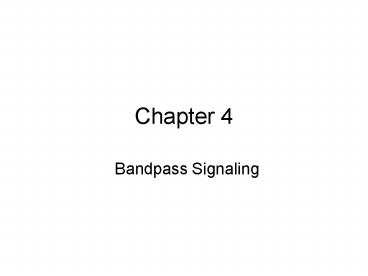Bandpass Signaling PowerPoint PPT Presentation
1 / 74
Title: Bandpass Signaling
1
Chapter 4
- Bandpass Signaling
2
In this chapter, we consider the situations where
the information from a source is transmitted at
its non-natural frequency (i.e., shifted
frequency). This process is called the
modulation.
- Representation of modulated signals
- Spectra
- Distortions (linear and non-linear)
- Functional blocks in bandpass communication
systems
3
Basic Model for Bandpass Communication
Source
Destination
Source can be analog or digital. The use of
channel is restricted around certain frequency,
fc (gtgt 0). For example, a radio station may be
given this frequency range for commercial
broadcasting. The goal is to recover the original
information, m, exactly or in the minimum, as
closely as possible.
4
Definition. A baseband waveform has a spectral
magnitude (and thus its power) concentrated
around f0 and zero elsewhere.Definition. A
bandpass waveform has a spectral magnitude
concentrated around ffc (fc gtgt 0) and zero
elsewhere. (fc carrier frequency)Definit
ion. Modulation translates the baseband waveform
from a source to a bandpass waveform with carrier
frequency, fc. baseband waveform
modulating signal bandpass waveform
modulated signal
5
Examples of Frequency Spectrum
- 300 Hz 20K Hz human voice / sound
- 50 kHz navigation (ships, submarines, etc)
- 1 MHz AM radio (20 k Hz channels)
- 10 MHz CB, short wave
- 100 MHz FM radio, TV
- 1 GHz UHF TV, mobile telephony
- 10 GHz amateur satellite
- 100 GHz upper microwave
- 10 T Hz Infrared
- 1015 Hz Visible light
- 1018 Hz X-rays
6
(No Transcript)
7
(No Transcript)
8
(No Transcript)
9
(No Transcript)
10
(No Transcript)
11
(No Transcript)
12
(No Transcript)
13
Bandpass Signals over Bandpass Channel
Channel
Out of Transmitter
Into Receiver
Can we translate this into a baseband model?
YES!
14
(No Transcript)
15
(No Transcript)
16
(No Transcript)
17
Equivalent Baseband Model for Bandpass Signals
Channel
Out of Transmitter
Into Receiver
Equivalent baseband impulse response
We can now decouple the complexity of shifted
frequency.
18
(No Transcript)
19
Distortionless Bandpass Channel
20
(No Transcript)
21
(No Transcript)
22
Types of (Analog) Filter
23
analog x(t)
analog y(t)
Digital Filter
A/D
D/A
manipulate digital data
24
(No Transcript)
25
(No Transcript)
26
(No Transcript)
27
Example of Non-Linear Distortion by Output
Saturation
28
Harmonic Distortion
29
(No Transcript)
30
Intermodulation Distortion (IMD)
31
(No Transcript)
32
IMD Analysis for Filter Output
33
(No Transcript)
34
Cross Modulation (Distortion)
35
Limiter
36
Mixer
input1(t)
output(t) input1(t) x input2(t)
input2(t)
37
(No Transcript)
38
(No Transcript)
39
The nonlinear device generates undesired
effects of product term between vin(t) and vLO(t).
40
Mixer Implementation through Switching
41
Double-Balanced Mixer
42
(No Transcript)
43
More on Frequency Multiplier
44
Detector Circuits
Source
Destination
45
Envelop Detector
low pass filter
46
(No Transcript)
47
Product Detector
48
(No Transcript)
49
(No Transcript)
50
Frequency Modulation Detector
51
Slope Detector (FM-to AM Conversion)
52
Slope Detector Circuit
53
Balanced Discriminator
54
Balanced Zero-Crossing Detector
55
(No Transcript)
56
(No Transcript)
57
Different Phase Detector Characteristics
58
(No Transcript)
59
(No Transcript)
60
Linearized PLL Model
61
Hold-in Range and Pull-in Range
Hysteresis indicates stored energy (or
inertia) in the PLL.
Hysteresis is useful against noises or unexpected
interruptions in received signals. This
is called the anti ping-pong characteristic.
62
(No Transcript)
63
(No Transcript)
64
(No Transcript)
65
(No Transcript)
66
Direct Digital Synthesis (DDS)
67
Generalized Transmitter (Type 1)
68
Generalized Transmitter (Type 2)
69
Generalized Receiver
70
(No Transcript)
71
Example of Image Frequency
72
Zero IF Receiver
73
(No Transcript)
74
Note. If the receivers were made in digital
circuit, the incoming signal must be sampled at
the bandpass frequency. It is not easy to do so.

